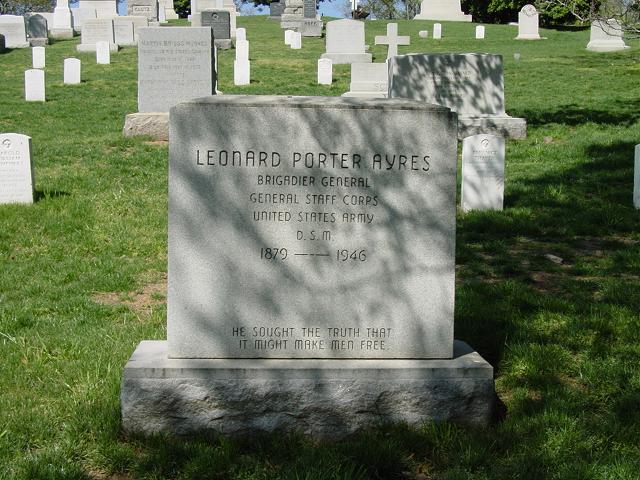Leonard Porter Ayres (1879 – 1946) was an American educator, born at Niantic, Connecticut. He received his college and graduate training at Boston, Harvard, and Columbia universities. He began teaching in 1902 as one of the first to carry American ideas and methods to Porto Rico. There he was appointed superintendent of schools in the districts of Caguas and San Juan, and later general superintendent of all the public schools on the island. Having returned to live in the United States, he was made head of the division of statistics in the Playground Association of America.
Beginning in 1908, he was prominently identified with the work of the Russell Sage Foundation, especially as chairman of the committee in charge of the Backward Children Investigation. In 1908-09 he lectured on education at New York University. Very many of his articles in educational journals have been reprinted, among them, The Effect of Promotion Rate on School Efficiency (1913). His writings on educational subjects , besides reports and contributions to periodicals, are:
- A Course of Study for the Schools of San Juan (1905)
- Medical Inspection of Schools, with Luther H. Gulick (1908)
- Laggards in our Schools (1909, 1913)
- Open Air Schools (1910)
- Seven Great Foundations (1911)
- A Measuring Scale for Ability in Spelling (1915, republished by Mott Media, Milford, Michigan 1985)
Ayres apparently tallied a count of the US Army battle deaths for World War I. He served as a Major during the war, or shortly thereafter.
Ayres was recalled to active duty in 1940 with the rank of Brigadier General. He retired in 1942.
He was awarded the Distinguished Service Medal.
Leonard Porter Ayres (1879 – 1946) was a U.S. statistician. Ayres apparently tallied a count of the US Army battle deaths for World War I. He served as a Major during the war, or shortly thereafter.
Posted Monday, Sep. 1, 1930
Above the gabble of minor seers there last week arose the well-respected voice of Col. Leonard Porter Ayres, studious vice president of Cleveland Trust Co. Distinguishing the present world-wide depression from the domestic depressions of 1924 and 1927, Col. Ayres, writing in Collier’s, predicted a turning point in the near future. “Now arises the emotion of fear,” he said. “Things ,,ere [last spring] brighter looking than they were. Now they look darker than they are. This is the last phase of the depression.”
The AYRES SPELLING SCALE: A Ready Made Literacy Scale
A MEASURING SCALE FOR ABILITY IN SPELLING, by Leonard Porter Ayres
First published in 1915 by the Russell Sage Foundation; Currently (1986) by Mott Media, Inc.,
Milford MI, ISBN 0-88062-039-0
One of the most elegant and carefully standardized tests available in the domain of literacy is the 1915 Ayres Spelling Scale, republished in 1986 thanks to the efforts of Geraldine E. Rodgers, of Lyndhurst, New Jersey, to whom this writer is much indebted for information on this, the McCall-Crabbs reading material, and the Rice Education Management references.
Ayres was first and foremost a statistician, and the elegance and simplicity of this scale illustrate the adage, “Simplicity is the ultimate sophistication.” Though the scale is easy to apply and use, it is not necessarily simple to understand the theory and design techniques embodied. It is worth the time to study. The scale consists of 1000 of the highest- frequency English words arranged in measured increments of ascending order of difficulty, and normed by grade levels, at 50th through 99th percentiles, from second through eighth grade. A copy of the Scale Heading is shown in Figure 1. The letters are the headings for each word list out of the 1000 words. The administering and scoring of a 20-word sample drawn from any one of the lists, when matched for percent and grade, will give the exact spelling grade level of any 2nd – 8th-grade student (as long as he scores at least 50%!). Ayres apparently believed that scores less than 50% were not
worthy of charting! The normative data was obtained through tests on 70,000 children in 84 cities across the U.S.
Quoting from Rodgers bibliographic notes, “It furnishes statistical proof, in contrast to today, that in 1915 virtually 100 percent of city children, including Blacks and foreign-born, could read at least simple material… and few children were more than two years behind the proper grade level for their age.”
Rodgers provides an interesting example of the use of the scale to rate present day spelling by a comparison with results from tests on 30,000 second graders in 1954. A 90- word list from the Follett Spelling Program was published with percentage-correct data from the Iowa Spelling Scale (State University of Iowa) in 1955. Of the 90 Follett test words for second graders, 67 were also on the 1915 Ayres List. The following lists show the 1954 Iowa percent-correct scores on
words which were also in the Ayres lettered columns. At the top of each list is the percentcorrect of 1915 second graders.
AYRES, LEONARD P
- Brigadier General, United States Army
- DATE OF BIRTH: 09/15/1879
- DATE OF DEATH: 10/29/1946
- BURIED AT: SECTION 2 SITE 1143
- ARLINGTON NATIONAL CEMETERY
Michael Robert Patterson was born in Arlington and is the son of a former officer of the US Army. So it was no wonder that sooner or later his interests drew him to American history and especially to American military history. Many of his articles can be found on renowned portals like the New York Times, Washingtonpost or Wikipedia.
Reviewed by: Michael Howard

